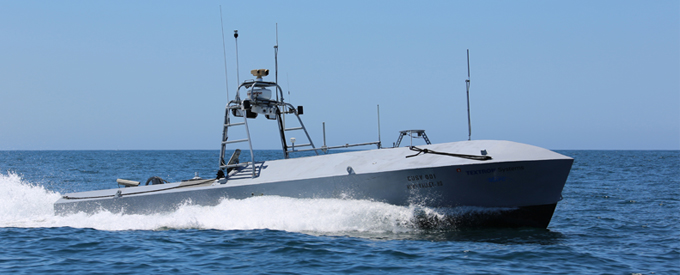2015-11-01
Role of unmanned systems to expand in future
In an exclusive interview to the Nation Shield journal, Bill Irby, Senior Vice President and General Manager, Textron Systems Unmanned Systems spoke at length of the wide applications of unmanned systems and the new technologies Textron Systems are pioneering in the segment considering the fact that unmanned assets excel at all critical “dull, dirty and dangerous’ work.
By Lee Yadav

Special operations groups are increasingly utilizing unmanned systems – what features and technologies can benefit them moving forward?
There are multiple unmanned aircraft system (UAS) advantages and technologies that can benefit special operators, all of which are functions of operational flexibility. One feature that they are looking for is rapid deployment without a large physical footprint. For example, we’ve designed our Aerosonde Small UAS to maintain a very small footprint for both sea- and land-based operations, and we are continuously evaluating ways to optimize system size and mobility further. We have even demonstrated a mobile configuration that is easily transported and set up from a small cargo van.
Endurance and reliability are also critical enablers. We worked with fellow Textron Systems business Lycoming Engines, the design and manufacturing authority for the purpose-built EL-005 used in the Aerosonde SUAS. This propulsion system has provided the Aerosonde levels of durability and reliability unmatched in its size class, while optimizing our aircraft size, weight and power. As a result, we are delivering more than 14 hours of endurance while providing day/night full-motion video, tactical communications relay, mesh networking and signals intelligence in a single sortie.
Finally, special forces demand operational agility. We offer a variety of business models for our Aerosonde SUAS, including system sales with training options, turnkey fee-for-service operations, and a hybrid approach in which we launch operations while providing instruction for customer operators and maintainers. We have launched some of our sites in well under 90 days.
Where are the current capability gaps with unmanned warfare, and what future innovations do we need to close them?
UAS technology is evolving rapidly, and with it our ability to continuously improve our systems and expand operational concepts into new domains.
For example, we are seeing customers adopt UAS technology in the maritime domain. Textron Systems invested time and money to translate its successful unmanned command-and-control platform to the maritime domain. The Common Unmanned Surface Vehicle (CUSV) is a mature, multi-mission and multi-payload capable vehicle with more than 2,000 hours of in-water operations experience. The fourth generation CUSV will be part of the United States Navy’s Unmanned Influence Sweep System program, currently in engineering and development phase.
Can systems be fielded rapidly and with a high level of technological readiness?
One of the keys to rapid and agile deployment is establishing system maturity. Our Aerosonde SUAS and the Shadow Tactical Unmanned Aircraft System (TUAS) have more than one million combined flight hours between them. With this established maturity under challenging operating conditions, customer requirements should then be analyzed carefully. Looking to more mature and reliable systems, then adding the needed capabilities, is a smart way to reduce program risk.
In the emerging marketplace, is unmanned systems innovation only about the vehicle? What other factors play a role?
Unmanned systems innovation encompasses much more than just the vehicle. This includes features like the sensors, navigation systems, command and control systems, and related interfaces. With the unique experience of working alongside our customers to operate, maintain and support our own systems in the field, we also look at the system lifecycle holistically – the entire logistics chain should be considered when identifying areas for innovation.
Do you see unmanned systems completely replacing manned combat systems in the near future?
There are many advantages to using unmanned systems for combat missions. For example, during persistent missions, unmanned systems can provide longer endurance to avoid pilot fatigue. Manned and unmanned assets of all kinds – in all domains – are inherently complementary, and I believe we’ll continue to see even greater acceleration in their teaming for military and civil applications. Unmanned assets excel at the far-reaching “dull, dirty and dangerous” work, delivering critical information to the manned asset and keeping personnel out of harm’s way.
What do you believe is the highlight of the next-generation Shadow M2?
Textron Systems began its investment and development of the next-generation Shadow M2 Tactical Unmanned Aircraft System in 2011. This system incorporates high-reliability propulsion and avionics systems for more than 12 hours of endurance and multi-mission performance.
Our dual-payload variant offers two internal payload bays, as well as wing-mounted hard points for additional sensors and payloads. A second variant is satellite communications (SATCOM) enabled for beyond-line-of-sight operations. With its multi-mission capability, power, and endurance, the Shadow M2 can accomplish many of the same mission sets as much larger, more expensive strategic systems. We have demonstrated the system for potential customers around the world, including delegations from Europe, the Mideast and Asia-Pacific.
Could you describe the Shadow V2?
To meet the emerging needs of the U.S. Army and other U.S. Department of Defense customers, Textron Systems currently is fielding an upgraded, all-digital Shadow system known as Version 2, or V2.
The Shadow V2 is an all-digital configuration, incorporating Ku-band compatibility and National Security Agency-approved encryption with the Tactical Common Data Link (TCDL). The TCDL also supports greater interoperability, while the full system is NATO standardization agreement 4586 compliant. The Shadow V2 aircraft is able to carry a high-definition electro-optic/infrared payload for full-motion, high-quality digital video imagery – supported by the greater data pipeline the TCDL affords. This is a highly capable, multi-mission system well suited to the advanced TTPs of the Army Aviation community, including manned-unmanned teaming.
AEROSONDE, CUSV and SHADOW are either registered trademarks or trademarks of AAI Corporation in the United States and/or other countries.



No Comments